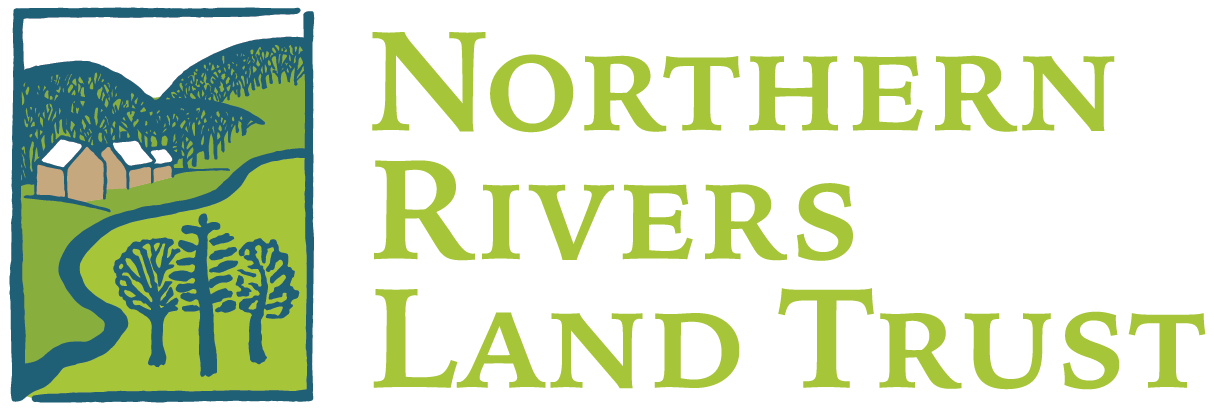Newsletter, November 2020 (No. 22)
Bertocci Family Donates Easement on 170 Acres in Wolcott
by Clive Gray
On August 18, 2020, acting on behalf of his brother and two sisters, Phil Bertocci of Philadelphia and Wolcott signed a conservation easement agreement with NRLT on their 170-acre property on Town Hill Road, Wolcott. This was the largest property thus far conserved with NRLT. It contains a hundred acres of managed forest including sugar bush, 63 acres of agricultural land including a 4-acre Christmas tree plantation, and a small pond. The Bertoccis donated the easement in memory of their father Angelo, an Italian immigrant who grew up imagining the wilderness of James Fennimore Cooper, and their mother Aili Kaukonen, a Finnish immigrant raised on a farm in Andover, VT.
As envisaged in the agreement, in October the Bertoccis sold 79 acres of their land to neighbor Ronnie Leroux, a farmer and contractor, thus converting the transaction into two conservation easements. The Bertoccis donated $5,000 of the purchase price to NRLT to cover the stewardship fee on the land trust’s easements.
Wolcott Pond: A Semi-Wild Jewel
by Laurie Gullion
The Northern Rivers Land Trust’s mission to protect the Wolcott Pond watershed gathered speed in 2020 when trustee Steve Young announced that he and Jan Roy are ready to place conservations easements on approximately 100 acres abutting the pond. These donations in concert with their son Gordon’s easement will advance the protection of Wolcott Pond’s largely undeveloped shoreline. When completed, the easements will conserve approximately 2,500 feet of shoreline—almost a half mile.
The NRLT with initial help from Sterling College’s Farley Brown and her Conservation Management students has collected data in a draft Wolcott Pond report that identifies the conservation values in the Wolcott Pond watershed. In October trustees identified five objectives in the report to protect the watershed’s character, including reaching out to additional landowners, seeking community support for continuing protection efforts, and encouraging scientific research that focuses on habitat changes over time.
Anglers, paddlers, and neighbors have long known the scenic beauty of this upland pond. However, there are some remaining unprotected shores as well as significant portions of the watershed. More data is needed to understand current water quality and the status of rare and threatened species identified more than 30 years ago. Our initiative provides a rare opportunity to connect the Wolcott Pond watershed to a patchwork of nearby protected parcels. Much work still needs to be done to enhance connectivity, but we remain committed to its growth with your help!
The Wolcott Pond Report is in draft form and will be finalized in 2021.
Why Wolcott Pond Is Special
by Steve Young
Wolcott Pond is unusual among the small lakes of north-central Vermont for several reasons. It escaped the rapid spread of ‘camp culture’ that resulted in the shores of most lakes being built up with summer camps on narrow lots. Currently there are only four camps on the shoreline, only two of which are visible from the water. In our area, only Long Pond in Greensboro and Hardwood Pond in Woodbury are less developed. In the case of Wolcott Pond, we now have the opportunity to maintain this undeveloped state permanently by acquiring a conservation easement on much of the most accessible property.
In earlier times some portions of the Wolcott Pond watershed were cleared for farmlands, but the land was always marginally productive, at best. Most farm activities had ceased by the mid 20th Century, and the fields and pastures have reverted to woodland. A major portion of the watershed was too rugged to have ever been cleared. Logging has occurred on this land over the years, but much of it has had little or no timber cutting for 50 or more years. While not true ‘old growth’ forest, many of the timber stands are well managed and contain a good mixture of mature tree growth and wildlife management openings. Careful and conservative forest management can be expected to continue, so the pond and its watershed provide a reasonable approximation of pre-settlement conditions.
The limnology of Wolcott Pond is unusual for Vermont. It has many attributes of a dystrophic lake. The water is rich in humic acids and other carbon compounds and is often brown in color, as is typical of lakes farther north.
The most unusual biotic feature of the shoreline is the stands of pink azalea (Rhododendron priophyllum) a species usually found farther south in the Appalachians. The only other northern Vermont station for this species has apparently been lost.
The first loons returned to Wolcott Pond in the late 1980s, and they have bred nearly every year since then.
Over the years, a good deal of scientific research has occurred in and around Wolcott Pond, although some of the data obtained is no longer available. The potential for more research is great. There are opportunities to study natural changes in the aquatic fauna and flora over time; for example, the pond has recently been colonized by northern water shield, (Brasenia schreberi) which appears to be spreading rapidly. Similarly, water lilies have become the dominant emergent aquatic plants only in the past few decades. There are also interesting opportunities in the shoreline vegetation, where tree stumps representing the pre-settlement forest may still be found. The current forest contains many mature white ash trees, which have, so far, not been attacked by the emerald ash-borer. It will be important to follow the condition of these trees over the next few years.

